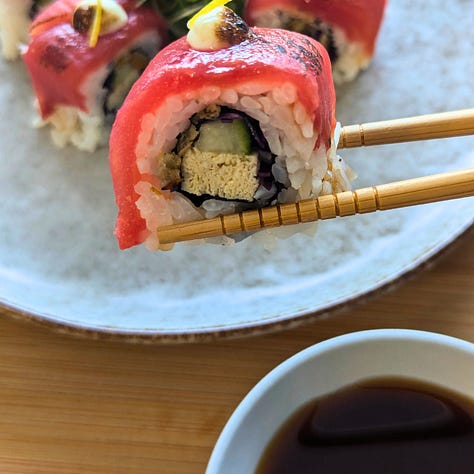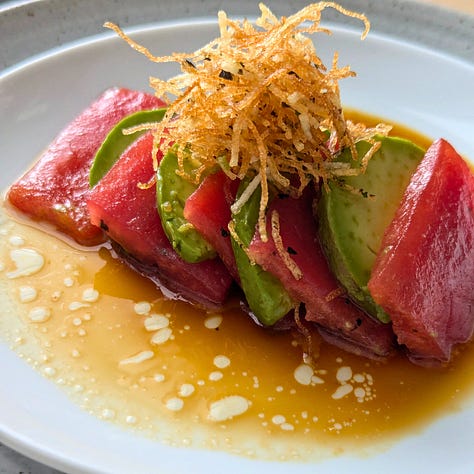Why Your Ponzu Tastes Like Lemonade
plus how to make one so good, you'll never reach for a bottle again
Dear Marisa,
I was looking up ponzu recipes the other day and got totally overwhelmed. They were all so different! I ended up picking a simple one that felt like what I thought ponzu was supposed to be: citrus flavored soy sauce.
But the result tasted…weird. It was sour and lemony, if that makes sense. And it didn’t taste ANYTHING like the ponzu my local sushi bar serves.
I still want to make it at home because my sushi chef won’t give up his recipe. But if it’s going to taste like lemonade flavored soy sauce, should I just buy the bottled stuff?
– Sour About Sauce
Dear Sour About Sauce,
Your question sparked my curiosity. I did a quick Google search to see what kind of ponzu recipes are floating around out there. And oh my…
While I did find a few good ones, I can absolutely see why you were overwhelmed. I saw recipes promising a “simple” ponzu made with nothing more than soy sauce and citrus juice. Others included additions like brown sugar, date molasses, and sesame oil.
Even in recipes that use the right ingredients, I noticed many skip the time needed for the flavors to develop. (I’m guessing the one you tried was a mix-and-go version.) Like many Japanese sauces that seem simple, ponzu contains small nuances that add subtlety and depth. Without them, it’s easy to end up with something that tastes too sharp or like you said lemonade flavored soy sauce.
But no worries! Good ponzu is totally doable at home. With the right ingredients, right proportions, and a little patience, you’ll get that bright, savory balance you’re craving.
– Marisa


What Is Ponzu?
Let’s start with what it isn’t. Ponzu is not just soy sauce with a splash of citrus.
The word ponzu is thought to come from the Dutch word pons meaning “punch” (as in a fruity citrus punch) which made its way into the Japanese culinary scene through early trade. And these days, there can be a little confusion: in Japan, bottled ponzu doesn’t always contain soy sauce. But in the West, when we say ponzu, we mean a citrus-based sauce containing soy sauce.
Ponzu Ratio and Ingredients Notes
I love a good ratio. It makes customizing the amount so much easier. If you prefer exact measurements, I do include a full recipe below.
4 parts soy sauce
4 parts citrus juice
1 part rice vinegar
½ part mirin
+ an umami steep
Salt (4 parts soy sauce)
Soy sauce is very important. You’ll want to use a Japanese style soy sauce and you’ll need to use the full blast version (aka NOT low-sodium) for best results.
Acid (4 parts citrus + 1 part rice vinegar)
One of the biggest mistakes I see is the use of just one citrus juice. Usually lemon.
Trust me, I learned this the hard way. In sushi school, we had access to the fresh Japanese citrus juices yuzu and sudachi. But at my first sushi job in Memphis, TN, those weren’t available. I made a giant batch of ponzu using only freshly squeezed lemons…and ended up with about two gallons of lemonade flavored soy sauce. To fix it, I had to make another batch with lime and grapefruit juice to mix in. Lesson learned.
If you can get your hands on yuzu juice, the flavor is worth it. But if that’s not available, use a blend of citrus for best results. Lemon, lime, and grapefruit is my preferred mix but mandarin orange can be used, too.
As for the vinegar, make sure it’s plain, unseasoned rice vinegar. The seasoned kind contains added sugar and salt, which will not work well for this recipe.
Sweet (½ part mirin)
A little hint of sweetness is what ties the acidity and salt together. It shouldn’t stand out, but it should be there. I use mirin (sweet Japanese cooking wine) with the alcohol burned off.
If you don’t have mirin on hand, try this:
Mix 2 tablespoons unseasoned rice vinegar with 1 teaspoon sugar, then heat until the sugar dissolves. (This makes enough to substitute the mirin in the recipe.)
Umami Steep (kombu + dried shiitake)
One of the nuances of ponzu is that it has the slightest bit of spunk. Traditionally, this comes from steeping katsuobushi (bonito flakes) in the mixture.
This version of ponzu is plant-based, but just as flavorful. Kombu (sea kelp) and dried shiitake mushrooms steep directly in the ponzu mixture for a full 24 hours. It’s not exactly fermentation, but after a day, the sauce begins to take on a spunkier character.
Ponzu Recipe
Whether I’m cooking for clients or making it for myself at home, this is my favorite ponzu. It’s bright, balanced, and reliably good.
Makes 2 cups
Time to steep: 24 hours
Ingredients:
1 cup soy sauce
½ cup fresh lime juice with pulp
¼ cup fresh lemon juice with pulp
¼ cup fresh grapefruit juice with pulp
¼ cup unseasoned rice vinegar
2 tablespoons mirin (with alcohol burned off)
1 (2-inch) square piece kombu
2-3 dried shiitake mushrooms
Method:
In a non-metal container, combine all ingredients and give it a gentle stir. Be sure to add any fruit pulp. Skip the rinds, though. They can leave your ponzu with a bitter aftertaste.
Cover tightly and let it sit at room temperature for 24 hours in a cool, dark spot.
After 24 hours, strain the mixture through a fine mesh strainer. At this point, it will already taste so much better than anything store-bought. But if you have the patience, let it rest in the fridge for a week before using.
Storage:
Keep refrigerated. Technically it should last for 3 months, but you’ll probably finish it much sooner.
Ponzu Uses



Good ponzu deserves a permanent spot in the fridge. I use mine frequently, especially when it’s hot outside.
Here are just a few ways I use it:
As a dip for sushi (You saw that one coming.)
Drizzled on top of hiyayakko (cold tofu)
Tossed with cold soba noodles
Stirred into melted butter as a sauce for tomato “tuna” sashimi
As a dipping sauce for gyoza, dumplings, or veggie tempura
Mixed with a little oil for a quick salad dressing
As a finishing drizzle on a platter of grilled vegetables. (It’s one of my favorite low-effort hosting tricks.)
Have Sushi Questions?
If you have a question you’ve always wanted to ask about sushi, Japanese ingredients, or even my own sushi journey, I’d love to hear it. No question is too small (Those are often my favorite!) You can send me a direct message or ask questions in the comments.









I have a dear friend who is vegetarian so I am enamored with your vegetarian approach to these delicious meals. I can’t wait finally share with him the sushi that I love.